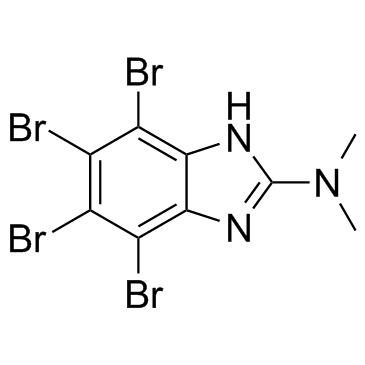749234-11-5
| Name | 4,5,6,7-tetrabromo-N,N-dimethyl-1H-benzimidazol-2-amine |
|---|---|
| Synonyms |
1zoe
Casein Kinase II Inhibitor II 2-Dimethylamino-4,5,6,7-tetrabromo-1H-benzimidazole CK2 Inhibitor II DMAT K25 |
| Description | DMAT is a potent and specific CK2 inhibitor with an IC50 value of 130 nM. |
|---|---|
| Related Catalog | |
| Target |
CK2:0.13 μM (IC50, Human CK2) PIM1:0.148 μM (IC50) PIM2:1.6 μM (IC50) PIM3:0.097 μM (IC50) HIPK2:0.37 μM (IC50) HIPK3:0.59 μM (IC50) DYRK1a:0.41 μM (IC50) DYRK2:0.35 μM (IC50) DYRK3:1.7 μM (IC50) PKD1:0.18 μM (IC50) CDK2:0.64 μM (IC50) |
| In Vitro | DMAT (1 μM-2.5 μM) DMAT is more efficient in killing antiestrogen resistant cells than parental antiestrogen sensitive MCF-7 cells. DMAT-induced cell death of antiestrogen resistant cells is mediated by caspases. DMAT inhibits CK2 activity but the inhibition is similar in the three cell lines, MCF-7, TAMR-1 and 182R-6[1]. DMAT has effects on H295R cell proliferation at concentrations of 10-4 and 10-5mol/Las compared with the control. DMAT (100 μM) significantly increases apoptosis of H295R cells. DMAT (1 nM-1 μM) significantly decreases aldosterone release into supernatants of 72-h H295R cell cultures as compared with the control[2]. DMAT also inhibits PIM1 by a mechanism which is competitive with respect to ATP, and it is a powerful inhibitor of kinases other than CK2[3]. |
| In Vivo | DMAT application in vivo reduces tumor growth in a xenotransplant model by interference with tumor cell proliferation. Biochemical parameters and histology following DMAT administration revealed no alterations in liver tissue[4]. |
| Kinase Assay | Kinase activity tests are performed in a volume of 50 μL containing (final concentrations): 0.1 μg/μL protein extract, 500 μM CK2 substrate peptide (RRRDDDSDDD), 25 mM Tris-HCl, pH 8.5, 100 μM Na3VO4, 1 mM DTT, 20 mM NaCl, 5 mM MgCl2, 50 μM ATP and appr 1 μCi [γ-32P]-ATP (3000 Ci/mmol). Samples are incubated for 10 min at 30°C. Aliquots are spotted onto P81 phosphocellulose paper and washed 3×5 min in 0.75% phosphoric acid and once in acetone. Incorporation of radiolabelled phosphate is measured by counting the samples in a liquid scintillation counter. Three independent experiments, each done in duplicate, are performed with reproducible results. |
| Cell Assay | H295R cells are plated at a density of 2×104 cells/well into 96-well microplates in complete culture medium and preincubated for 12 h (5% CO2, 37°C, 95% humidity). DMAT in 96% ethanol and Nu-Serum-free culture medium is added to the appropriate wells at final concentrations of 10-4-10-10 M (the highest concentration of ethanol is 1.8% [vol] in the 10-4 M wells). The same volume of Nu-Serum-free culture medium and 96% ethanol is added to the control wells at the same concentration as the solvent in the 10-4 M group. Incubation is performed for 72 h under standard conditions (5% CO2, 37°C, 95% humidity). The absorbance (OD, optical density) of each sample is measured with an enzyme-linked immunosorbent assay (ELISA) microplate reader at a wavelength of 450 nm. |
| References |
| Molecular Formula | C9H7Br4N3 |
|---|---|
| Molecular Weight | 476.78800 |
| Exact Mass | 472.73700 |
| PSA | 31.92000 |
| LogP | 4.67890 |
| Storage condition | 2-8℃ |
